Direct anterior approach vs Hardinge in obese and nonobese osteoarthritic patients: A randomized controlled trial
George Macheras, Sophia Stasi, Michail Sarantis, Athanasios Triantafyllou, Dimitrios Tzefronis, Stamatios A Papadakis
George Macheras, Michail Sarantis, Dimitrios Tzefronis, 4th Orthopaedic Department, “KAT” General Hospital of Attica, Athens 14561, Kifissia, Greece
George Macheras, Sophia Stasi, Athanasios Triantafyllou, Laboratory of Neuromuscular and Cardiovascular Study of Motion (LANECASM), Physiotherapy Department, University of West Attica, Athens 12243, Egaleo, Greece
Stamatios A Papadakis, 2nd Orthopaedic Department, “KAT” General Hospital of Attica, Athens 14561, Kifissia, Greece
Abstract BACKGROUND The increased prevalence of obesity has resulted in orthopedic surgeons being likely to face many patients with a high body mass index (BMI) who warrant total hip arthroplasties (THAs) over the coming years. Studies' findings considered the postoperative clinical, and functional outcomes in these patients are controversial, and selecting the most appropriate surgical approach remains debatable.AIM To compare pain-levels, functionality, and quality-of-life in obese and nonobese osteoarthritic patients who have undergone primary total hip arthroplasty through either direct-anterior-approach (DAA) or Hardinge-approach.METHODS One hundred and twenty participants (> 50 years) were divided into four groups according to the surgical approach (DAA or Hardinge) and patients' BMI (nonobese < 30 kg/m2 vs obese ≥ 30 kg/m2). Outcomes were measured preoperatively and postoperatively (6th and 12th week). Pain was measured with Face Pain Scale-Revised (FPS-R). Functionality was measured with Timed Up & Go (TUG) test and Modified Harris Hip Score-Greek version (MHHS-Gr). Quality-of-life was evaluated with the 12-item-International Hip Outcome Tool-Greek version (iHOT12-Gr) (Clinical Trial Identifier: ISRCTN15066737).RESULTS DAA vs Hardinge: (week 6) DAA-patients showed 12.2% less pain, more functionality (14.8% shorter TUG-performance time, 21.5% higher MHHS-Gr), and 38.16% better quality-of-life (iHOT12-Gr) compared to Hardinge-patients (all P values < 0.001). These differences were further increased on week 12 (all P values ≤ 0.05)]. DAA-obese vs Hardinge–obese: (week 6) DAA-obese patients had less pain, shorter TUG-performance time, better MHHS-Gr and iHOT12-Gr scores than Hardinge-obese (all P values < 0.01). (Week 12) Only the TUG-performance time of DAA-obese was significantly shortened (22.57%, P < 0.001). DAAnonobese vs DAA-obese: no statistically significant differences were observed comparing the 6th and 12th weeks' outcomes.CONCLUSION DAA-groups reported less pain, more functionality and better quality-of-life, compared to the Hardinge-groups. The DAA benefited obese and nonobese patients, similarly yet faster, suggesting that it should be the more preferred choice for obese patients, instead of Hardinge. However, more comparative studies with more extended follow-up periods are needed to confirm our results and better evaluate all patients' long-term outcomes.
Key Words: Total hip arthroplasty; Osteoarthritis; Obesity; Pain; Functional ability; Quality-of-life
INTRODUCTION
In recent years, there has been a growing interest in minimally invasive surgical techniques that are used for the performance of total hip arthroplasty (THA). The advantages of these techniques include lesser soft tissue trauma, lesser amount of blood loss, minor postoperative pain, shorter hospital stay, better aesthetic appearance of the incision and a faster recovery time[1-3]. Over the past decade, the direct anterior approach (DAA) has sparked scientific interest due to its soft-tissue-preserving nature (intermuscular and internerval technique), coupled with the relatively lower risk of dislocation[4]. The DAA approach can be performed through a vertical or a horizontal (bikini) incision[5].
On the other hand, THA is an effective treatment for most patients who suffer from pain and decreased functionality due to end-stage symptomatic hip osteoarthritis (OA)[6]. Epidemiological studies report that hip OA occurs in 88 out of 100000 people, and the reported prevalence was 0.9 and 1.6 per 1000 yearly, in both men and women, respectively[7]. Within the Greek population, 0.9 per 1000 people develop osteoarthritis of the hip and the incidence of the disease is 1.5 per 1000 in women and 0.3 per 1000 in men[8]. The main risk factors for developing hip OA are advanced age, family history of OA, previous hip injury, hip dysplasia and obesity. Specifically, obesity is a high-ranking risk factor for osteoarthritis development, as its effect increases the joint reaction forces and alters gait biomechanics by creating abnormal loadings[9]. Additionally, the increased accumulation of body fat and adipokines contributes to low-grade systemic inflammation that adversely affects the cartilage's normal biology[10]. In the literature, it has been reported that obesity is significantly associated with a greater need for joint replacement and that compared to patients with normal body mass index (BMI), obese patients may require a THA up to ten years earlier[9].
Several studies have indicated that obesity is associated with both a higher complication rate after THA and poorer clinical functional outcomes[11-13]. Other studies have shown that obese patients do not differ from nonobese in terms of postoperative outcomes[14-16]. The data are considered controversial and further studies need to be performed on obese patients, especially comparative evaluations that compare minimally invasive techniques such as DAA with classical surgical techniques, such as the Hardinge approach (HA). The Hardinge was chosen because, compared to other classical surgical approaches used in obese patients, it offers better access to the hip joint and achieves a lower rate of dislocation by preserving the joint's posterior stabilizer muscles[17].
This trial aims to compare DAA and Hardinge in hip OA patients who have undergone primary THA, with regards to postoperative pain levels, functional status, and quality-of-life. In addition, it was investigated whether these parameters differ between obese and nonobese patients.2021
MATERIALS AND METHODS
Study design
The present study was a prospective, four-group randomised controlled trial (Clinical Trial Identifier: ISRCTN15066737) conducted according to the ethical principles stated in the Declaration of Helsinki and its later amendments[18]. The Scientific Research Council of the "KAT" General Hospital of Attica, Athens, Greece approved the study's protocol (ref: No8/19-03-2019). The study conformed to the "Consolidated Standards of Reporting Trials" (CONSORT) 2010 Statement checklist of information to include when reporting a randomised trial[19].
Sample size estimation
It was estimated that a sample size of 120 patients was required in order to have a 90% probability of demonstrating a –between surgical approaches- difference of 10% change from baseline to 6week (DAA: -50% ± 12%Harginge: 40% ± 12%) in TUG test performance time, with a significance of < 5% (Two-tailed test).
Participants
Participants were selected from patients who have chosen to be operated by either of the two chief orthopedic surgeons/co-researchers of the present trial. One of the headorthopedic surgeons (GM) performs primary THA using DAA technique -through a single vertical incision-[20], whilst the other (SP) prefers the Hardinge[21]. Surgical approach and BMI were used as factors in the randomisation process, while the randomisation list was formed on the basis of these factors. An independent clinician was responsible for the random allocation sequence and assigned participants to groups. Specifically, participants were divided into four groups (30 patients per group) according to both the surgical approach used and their body mass index (BMI), as follow: (1) DAA-nonobese group: patients with BMI ≥ 20 kg/mand < 30 kg/m, who underwent THA through DAA; (2) DAA-obese group: Patients with BMI ≥ 30 kg/m, who underwent THA through DAA; (3) Harginge-nonobese group: patients with BMI ≥ 20 kg/mand < 30 kg/m, who underwent THA through Harginge; and (4) Harginge-obese group: patients with BMI ≥ 30 kg/m, who underwent THA through Harginge.
To be eligible for randomization, patients had to meet the following inclusion criteria: Symptomatic hip OA, age > 50 years, and to be ambulatory before surgery. Patients were excluded if they had dementia, chronic respiratory disease, chronic renal failure, heart failure or neurological disorder. In addition, after discharge, patients would also be excluded if they discontinued the postoperative physiotherapy before the 6week's measurement. No patient or clinician was blinded to the group allocation.
Αn uncemented prosthesis was used in all patients. Physiotherapy intervention was started on the first postoperative day and lasted for 6 wk, firstly on an in-patient basis, and following hospital discharge, home-based. One physiotherapist was responsible for carrying out the physiotherapy during hospitalization and at home, evaluating the progress according to the protocol and ensuring the patient's compliance adherence to it, on all groups.
Procedures
Outcome measures were obtained at three different time points: prior to surgery (baseline), at the end of the 6week, and at the end of the 12week, postoperatively. Pain-levels were measured with the Face Pain Scale – Revised (FPS-R)[22,23]. Functional ability was evaluated with the objective physical performance measure Timed Up & Go (TUG) test[24], and with the reliable and validated Greek version of the Modified Harris Hip Score (MHHS-Gr)[25]. Quality-of-life was measured with the reliable and validated Greek version of the International Hip Outcome Tool -12 items (iHOT12-Gr)[26]. One examiner carried out the measurements of all outcomes, and he did not involve in any other part of the study.
Outcome Measures
The FPS-R is a patient-reported instrument frequently used to measure pain intensity. It includes six facial expressions covering the entire range of pain levels in an ascending -regarding discomfort levels- order[22]. Patients describe their pain according to one of the six facial expressions that correspond to their pain and enabling them to translate their subjective experience of pain into a quantitative, numeric measure[23].
The TUG test was used to assess participants' functionality. This test was introduced in 1991 as a modification of the "Get-Up and Go" test[24]. It is a simple, easy, and thus widespread clinical tool for measuring the lower limbs' functionality and mobility[27]. The TUG test measures the time (in seconds) taken by a participant to stand up from an armed chair with a seat height of 46 cm, walk for 3 m, turn around a cone and return to sit on that very same chair. A shorter performance time represents better functionality[24,27]. Participants were asked to perform the test as quickly as they could while still feeling safe, and were allowed to use the walking aid on which they depended on at the time of measurement. The participants performed the test twice, with a 5-minute resting interval in between. The shorter of the two performance times was then recorded.
The MHHS is a patient-reported questionnaire that includes assessments based on pain and on function[25]. One item evaluates the pain (0-44 points), while 7 items evaluate the patient's functionality (0-47 points). The total points form a scale from 0 to 91. A multiplier of 1.1 provides a total score of 100 (best possible outcome)[28].
The iHOT12 questionnaire includes 12 questions on the patient's symptoms, functional and sports limitations as well as social, emotional, and occupational limitations[26]. The patient is asked to consider the problems arising from their hip disorders and quantify their quality-of-life level on a 100 mm horizontal line (visual analogue scale) by marking it with a slash. Each question has equal value, giving a mean score from 0-100. A score of 100 indicates excellent quality-of-life (full function and no symptoms), whereas zero signifies the worst quality-of-life (maximum limitations and extreme symptoms)[29].
Statistical analysis
Data was expressed as mean ± SD or mean ± SE (for two way ANOVA analysis results) for continuous variables and as percentages for categorical data. The Kolmogorov—Smirnov test was utilized for normality analysis of the continuous variables.
The two-way ANOVA model was used to examine the interaction between the "Surgical Approach" factor (DAA & Hardinge) and "BMI" factor (< 30 kg/mand ≥ 30 kg/m). In the case that there was no statistically significant interaction, we compared the factor "Surgical Approach" regardless of "BMI" factor and the factor "BMI" regardless of "Surgical Approach" factor.
Due to we have found significant interaction, we created a new factor categorising the combination of the existing categories of "Surgical Approach" with "BMI" factors (DAA-nonobese, DAA-obese, Hardinge-nonobese, Hardinge-obese). The analysis of variables was performed using the "One way ANOVA model". Pairwise comparisons were performed using the Bonferroni test.
All tests were two-sided and statistical significance was set at< 0.05. All analyses were carried out using the statistical package SPSS v21.00 (IBM Corporation, Somers, NY, United States).
RESULTS
Descriptive and clinical data
Patient recruitment lasted from January 2018 to March 2020, by which time the required number of participants had been reached. The recruitment procedure is depicted in the flow diagram in Figure 1. Eight patients (one from DAA-nonobese group, two from DAA-obese group, two from Hardinge–nonobese group and four from Hardinge-obese group) were lost to follow up due to wound healing problems. Finally, data from 120 patients (30 patients per group) were analysed (Figure 1). There is homogeneity between compared groups for all demographic and clinical characteristics apart from weight (< 0.001) and BMI (< 0.001), as expected (Table 1). At baseline, there is a statistically significant difference between compared groups in relation of variables, FPS-R (= 0.045), TUG (= 0.033), MHSS-Gr (< 0.001); except iHOT12-Gr (= 0.100) (Table 1); hence, the percentage (%) of changes of all variables/outcome scores in between groups - from baseline to 6and 12week- were presented.
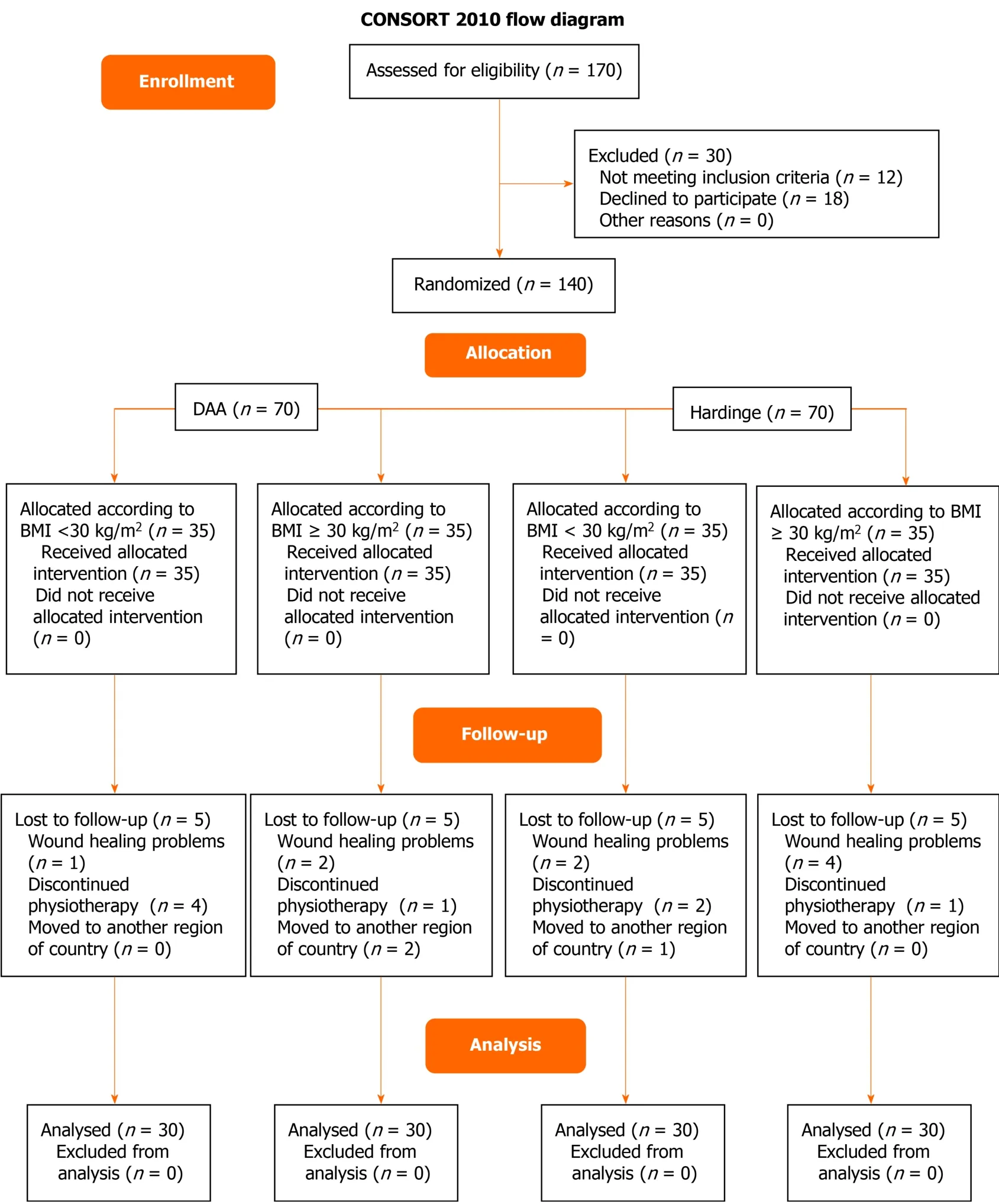
Figure 1 The flow diagram of the study.
The comparison of all variables/outcomes' scores during the observation period per group, showed that its absolute values were statistically significant different (< 0.001) (Table 2). Patients of all groups benefited from the THA regarding the pain's level, functionality and quality-of-life.
The exploration of interaction between "BMI" and "Surgical Approach" factors revealed statistically significant difference in pain-levels (FPS-R) at 12week [F(1.116) = 4.11,= 0.045] (Table 3). Exploring the data to illustrate the source of that interaction, we also compared the percentage of change of the other variables/ outcome measures (TUG, MHHS-Gr, iHOT112-Gr) from baseline to 6and 12week: a) across the two surgical approaches by BMI-level, and b) across BMI-level per surgical approach, adjusting significance cut-off points for multiple comparison.
Comparative results
DAA Hardinge regardless of BMI:At the 6postoperative week's measurements, DAA patients reported 12.2 % lesser pain (FPS-R), more functional ability (14.8% faster TUG test performance time and 21.5% higher MHHS-Gr score), and 38.2% better quality-of-life (iHOT12-Gr) compared to Hardinge patients, with statistically significant differences (allvalues <0.001) (Table 4). At 12postoperative week's measurements these differences of both DAA groups' outcomes were further increased [FPS-R: 9.9% (< 0.001), TUG test: 21.2 % (< 0.001), MHHS-Gr: 22.5% (= 0.05), and iHOT12-Gr: 40.5% (< 0.001)] (Table 4). The DAA resulted in less postoperative pain, and offered faster and increased functional ability and better quality-of-life compared to the Hardinge.
DAA-nonobese Hardinge-nonobese:At the measurement of the 6postoperative week, the DAA-nonobese group had better % percentage of change in all outcomes: [FPS-R: 14.8% (< 0.001), TUG test: 13.5 % (< 0.001), MHHS-Gr: 16.5% (= 0.026), and iHOT12-Gr: 44.9% (< 0.001)] in comparison to the Hardinge –nonobese (Table 4). At the 12postoperative week's measurements the DAA-nonobese FPS-R was lowered by 14.0% (< 0.001), the TUG test performance time was shortened by 19.8 % (< 0.001), and iHOT12-Gr got higher by 41.7% (= 0.048), than Hardinge –nonobese. Although the DAA-nonobese group MHHS-Gr was higher by 11.5%, no statistically significant difference was revealed (= 0.777) (Table 4). The DAA leads faster to better functional ability and quality-of-life compared to the Hardinge, in nonobese patients.
DAA-obese Hardinge-obese:At the 6postoperative week's measurements DAAobese patients had a greater % percentage of change of all outcomes [FPS-R: 9.7% (= 0.002), TUG test performance time: 16.0% (< 0.001), MHHS-Gr: 26.6% (= 0.012), and iHOT12-Gr: 31.4% (= 0.031) compared to Hardinge-obese patients (Table 4). At the 12postoperative week's measurements, the only statistically significant difference was revealed at TUG test performance time of DAA-obese: 22.6% (< 0.001), while the differences of the FPS-R, MHHS-Gr and iHOT-Gr were not statistically significant (Table 4). Regarding obese patients, DAA leads faster to better functional ability and quality-of-life compared to the Hardinge; at 12 wk the statistically significantdifferences between groups were narrowed.
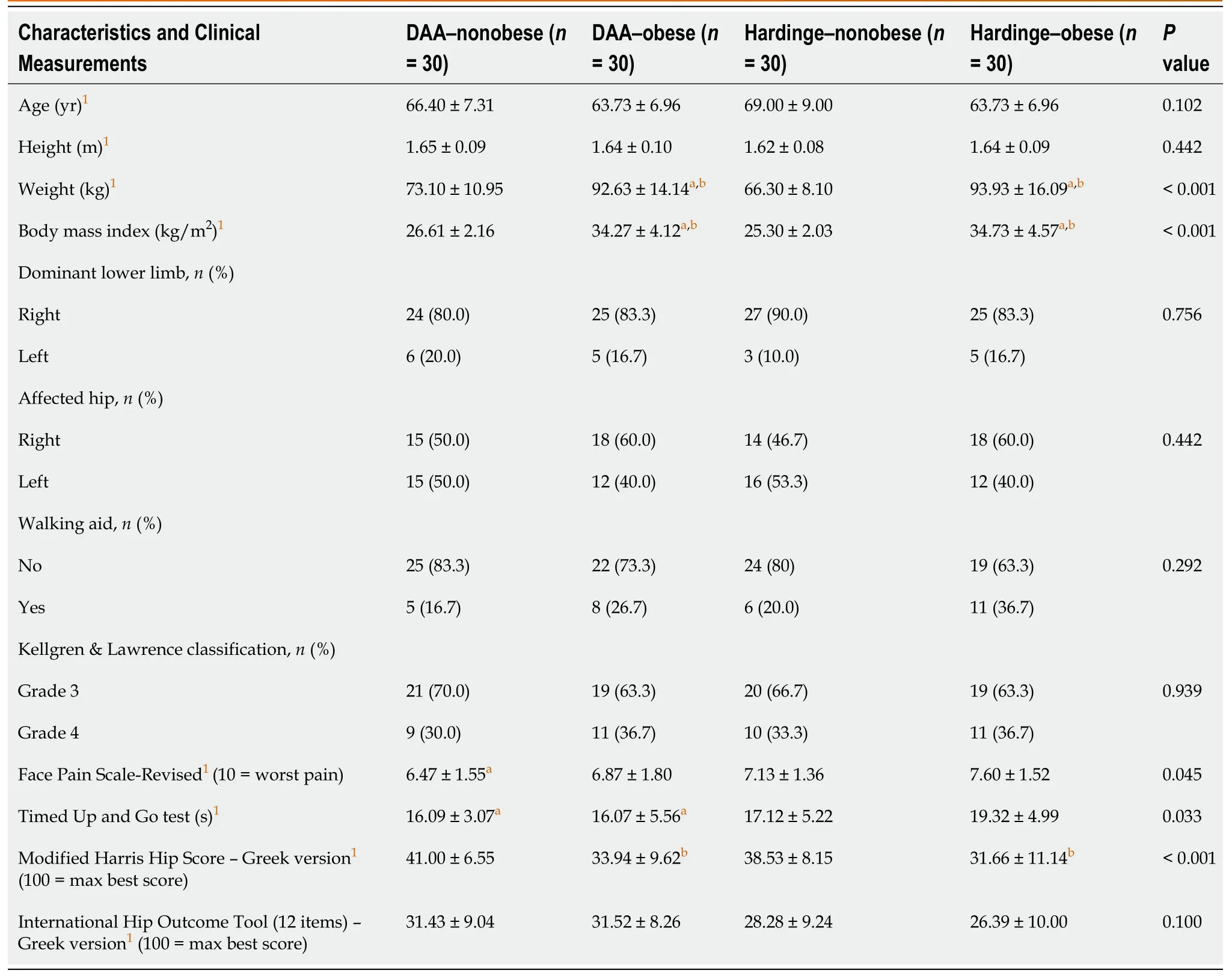
Table 1 Demographic characteristics and clinical measurements of the study sample (n = 120)
Nonobese obese regardless of surgical approach:At the 6postoperative week's measurements obese patients reported higher MHHS-Gr (16.8%) with statistically significant difference (= 0.001) than nonobese. No statistically significant differences were revealed regarding the other outcomes (Table 5). At the 12postoperative week's measurements obese patients' MHHS-Gr score was further increased (37.5%,= 0.001), but still no statistically significant differences were revealed regarding the other outcomes (Table 5). Overall, regardless of the surgical approach, the only statistically significant difference between obese and nonobese patients was revealed in the selfreported functional ability as expressed by the MHHS-Gr questionnaire.
DAA-nonobese DAA-obese:At the 6postoperative weeks' measure-ments, no statistically significant differences were observed in the comparison of postoperative outcomes (Table 5). Likewise, no statistically significant differences were observed in comparing postoperative outcomes at the 12postoperative weeks' measurements (Table 5). The DAA similarly benefited both obese and nonobese patients.
Hardinge-nonobese Hardinge-obese: At the 6postoperative weeks' measurements, no statistically significant differences were observed between Hardingenonobese and Hardinge-obese groups (Table 5). At the 12postoperative weeks' measurements, only the TUG test performance time of Hardinge-nonobese patients was significantly shorter (5.5%,= 0.001) compared to Hardinge-obese patients (Table 5). Overall, Hardinge-nonobese reached in higher functionality, as expressed byTUG test, than Hardinge-obese patients.
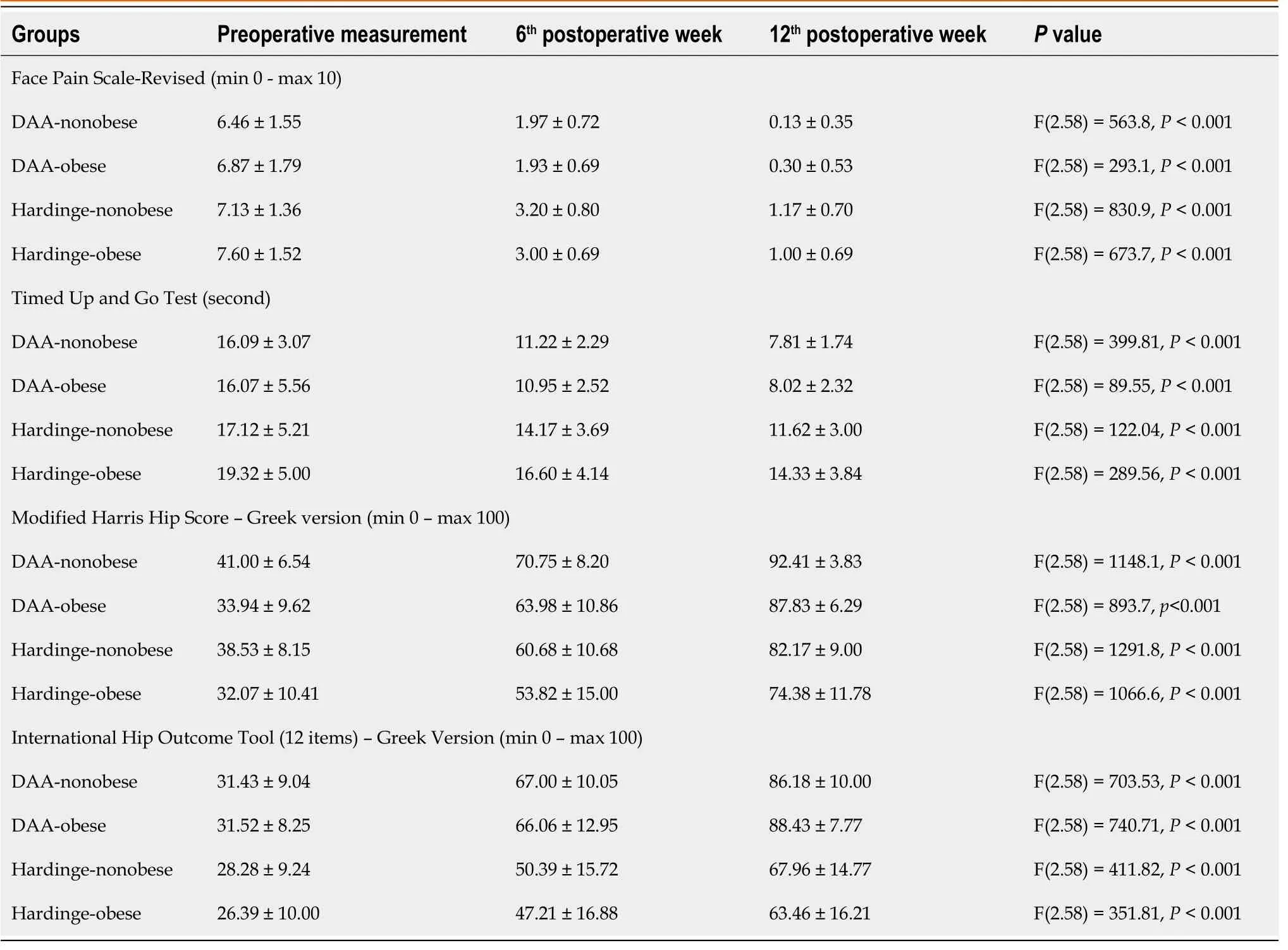
Table 2 Comparison of outcomes’ scores during the observation period per group

Table 3 Interaction between “body mass index” and “surgical approach” factors
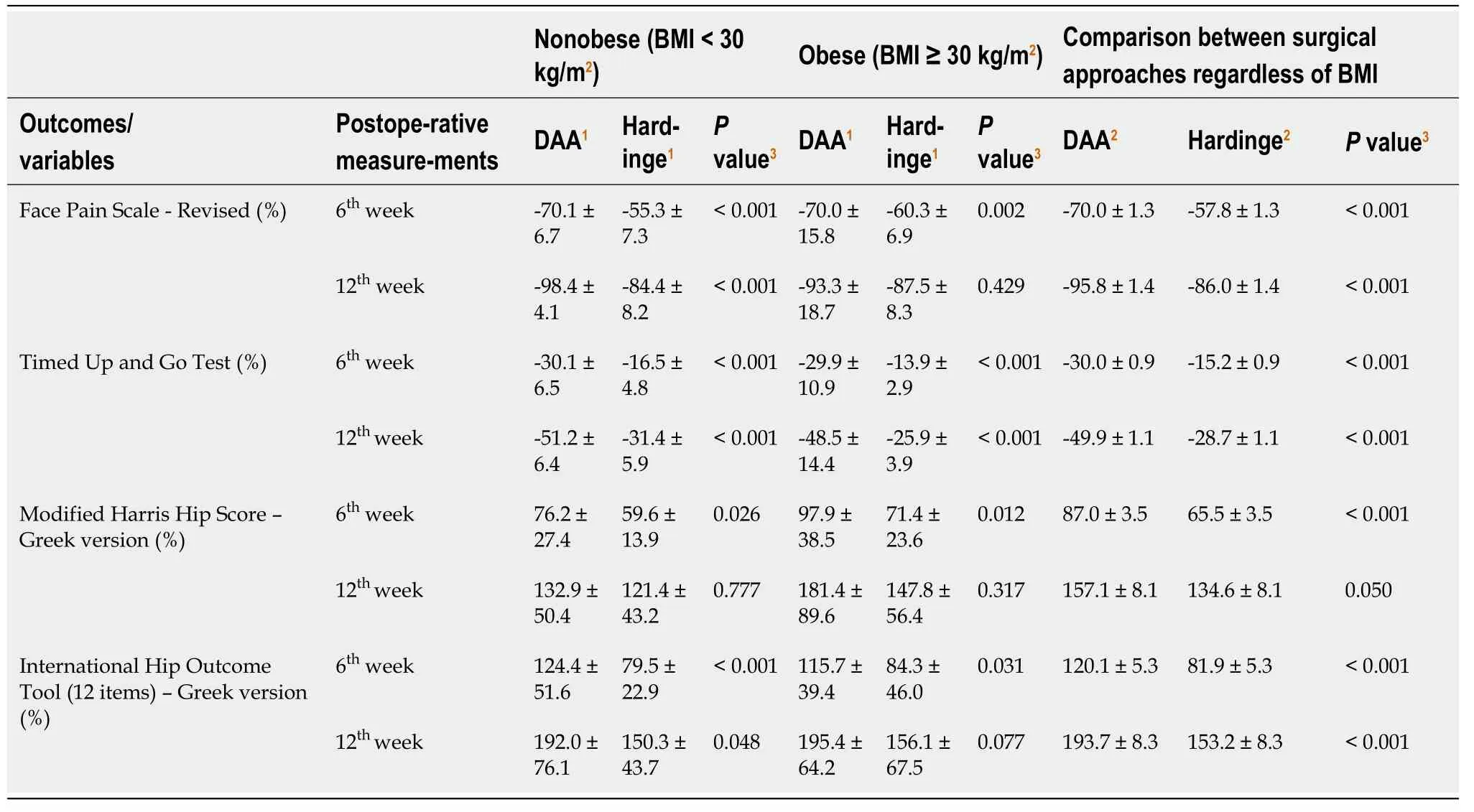
Table 4 The % percentage changes of outcome scores, between surgical approaches, according and regardless of body mass index, compared to corresponding baseline measurements
DISCUSSION
In the present study, the effect of two different THA surgical approaches (DAAHardinge) on postoperative pain levels, functionality and quality-of-life in both obese and nonobese hip OA patients was explored. Our results showed that the DAA resulted in less postoperative pain, and offered faster achieved and increased functional ability and better quality-of-life compared to the Hardinge. In addition, the measured outcomes of the aforementioned parameters did not differ between obese and nonobese DAA patients; DAA similarly benefited both obese and nonobese patients.
The selection of the best surgical approach for THA remains a matter of debate. While Hardinge is widely used, mainly due to its reduced dislocation rate[17], DAA is gaining popularity as its intermuscular pathway preserves soft tissues, ensuring an excellent functional outcome and reduced postoperative pain[4]. Our results are in line with other studies which suggest that DAA is more beneficial to the patients in terms of postoperative pain relief and faster recovery, than Hardinge[30]. A recent metaanalysis has concluded that, in comparison to the lateral approach, the anterior approach is correlated with reduced pain at 6 wk postoperatively, increased walking velocity, stride length and step length, while no difference was found in the Harris Hip Score and the rate of complications[31]. In the present study, we found that DAA was associated with higher pain relief, enhanced functional outcomes and quality-of-life at the 6week, while these outcomes increased even more at 12week.
Several studies have shown that obese patients do not differ from the nonobese ones in terms of postoperative outcomes[14-16]. Similarly, in the present study, both obese and nonobese patients of DAA groups reached equivalent pain-levels, functionality and quality-of-life, suggesting that BMI is indeed not a factor that will influence the postoperative outcomes of DAA. However, this was not observed in Hardinge-groups. Although at 6weeks' measurements, no statistically significant differences were observed between Hardinge-nonobese and Hardinge-obese groups, at 12week, Hardinge-nonobese presented significantly improved TUG test performance time in comparison to Hardinge-obese patients. This could be explained by the fact that, preoperatively, Hardinge-nonobese had no-significant shorter TUG test performance time than Hardinge-obese (Table 1), which became significant after the THA.
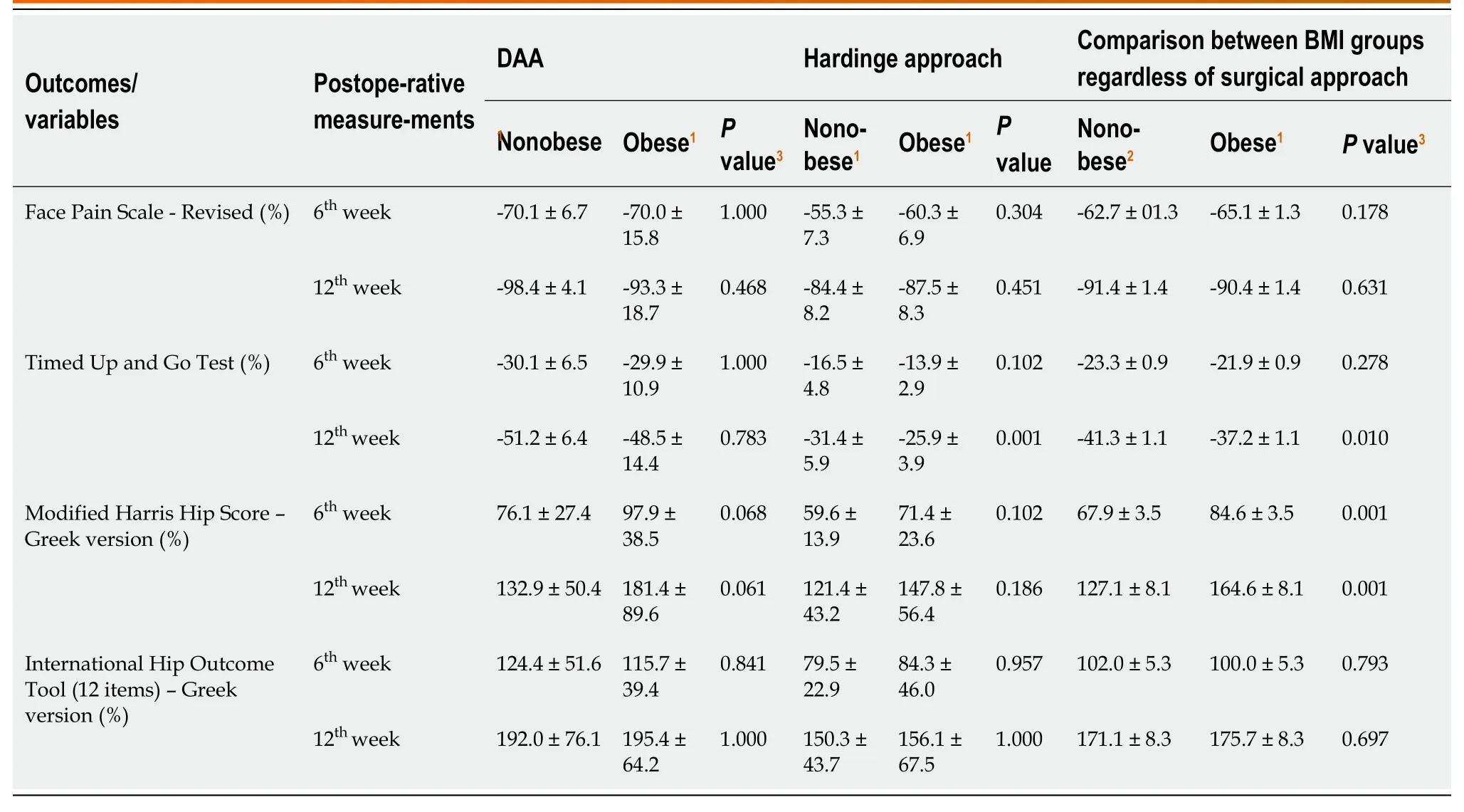
Table 5 The % percentage changes of outcome scores, between body mass index groups, according and regardless of surgical approach, compared to corresponding baseline measurements
The comparison between obese patients showed that, DAA leads faster to better functional ability and quality-of-life compared to the Hardinge. At 12postoperative week's measurements, the only statistically significant difference was revealed at TUG test performance time of DAA-obese group. This is not surprising since it is well known that the hip abductor strength improved at 3 mo following THA performed by a conventional approach, such as Hardinge[32], while the hip abductor strength was linear associated with TUG test[33].
In the present study, most cases with wound healing problems were reported in Hardinge-obese patients (four out of 35 patients, 11.4%), as shown in our flow diagram. This rate was lower than the rates reported in the literature, for obesepatients, on other classical surgical approaches, ranging from 14.5% to 22%[34,35]. Regarding DAA, one incidence in nonobese and two incidences in obese participants were found (3.5 % and 5.7%, respectively). The study's results are within the rates reported in the literature: for DAA-nonobese ranging between 0.8% and 3%, while for DAA-obese patients ranging from 4.46% to 10.0%[36-38]. It is worth to be noted that the horizontal (bikini) incision was shown to facilitate even more wound healing in obese patients. In the retrospective comparative study by Manrique[39], involving obese patients (BMI > 30 kg/m) it was reported that patients with horizontal incision had significant lower rates of wound healing problems compared to patients with vertical incision (0.00%16.6%,= 0.04)[39]. Nevertheless, the current evidence is limited, and further trials are warranted to identify differences between the two DAA skin incisions regarding wound healing in obese patients.
While the risks associated with THA in obese patients are well documented [11,34], the present study results show that DAA would be a preferable THA approach for obese patients. Since it is a minimally invasive surgical technique that provides the most direct access to the hip joint, DAA can be safely performed, by an experienced surgeon and under certain precautions, without an increased and adverse risk for obese patients[4,40].
Strengths and limitations
The present study was a four-group randomised controlled trial. All patients underwent uncemented THA, and the same physiotherapist was responsible for the physiotherapy intervention in all four groups. After discharge, the supervision and guidance from the physiotherapist, during in-home sessions, helped ensure patient adherence to protocol and thus, the study's dropout rate was minimal. Moreover, all measurements were made by the same examiner, who was not involved in any other part of the study. These factors added strength and statistical power to the results of this study.
On the other hand, there are important limitations that ought to be mentioned. Patients were followed up until the 12postoperative week; it is, therefore, unclear whether the observed postoperative differences between DAA and Hardinge will be maintained over time, even though several studies consistently showed better outcomes with DAA during functional rehabilitation within one year of surgery[41-44]. However, the fact that DAA allowed our patients to achieve a more rapid recovery than Hardinge concluded to their postoperative rehabilitation being less costly, since their independency was faster obtained, regardless of BMI. Another limitation is that DAA and Hardinge were performed by two different orthopaedic surgeons, a fact that may predispose biased conclusions. Even though our results are indicative, further research is needed to produce safer results regarding the impact of obesity in pain, functional outcomes, and quality-of-life after THA in between different approaches, which is ultimately more appropriate for obese hip OA patients.
CONCLUSION
In conclusion, the patients of our study reported less pain, more functionality and quality-of-life improvements, more so after THA with DAA, compared to the Hardinge. Moreover, DAA exhibits equivalent postoperative outcomes in obese and nonobese patients, suggesting a better-suited THA surgical approach for patients with increased BMI. Understanding the postoperative changes in pain's level, functional outcomes and quality-of-life in both obese and nonobese patients, as reported in the current study, will be helpful for both the patients and the surgeons regarding the decision-making process for the more appropriate THA surgical technique.
ARTICLE HIGHLIGHTS
Research background
Total hip arthroplasty (THA) is an effective treatment for most patients who suffer from pain and decreased functional ability due to hip osteoarthritis (OA). The main risk factors for developing hip OA are advanced age, family history of OA, previous hip injury, hip dysplasia, and obesity. The increased prevalence of obesity has resulted in orthopedic surgeons being likely to face many patients with a high body mass index(BMI) who warrant THAs over the coming years. On the other hand, there has been growing interest in the direct anterior approach (DAA) in recent years because of its soft-tissue–preserving nature. Total hip arthroplasty (THA) is an effective treatment for most patients who suffer from pain and decreased functional ability due to hip osteoarthritis (OA). The main risk factors for developing hip OA are advanced age,family history of OA, previous hip injury, hip dysplasia, and obesity. The increased prevalence of obesity has resulted in orthopedic surgeons being likely to face many patients with a high body mass index (BMI) who warrant THAs over the coming years. On the other hand, there has been growing interest in the direct anterior approach (DAA) in recent years because of its soft-tissue–preserving nature.
Research motivation
In the literature, it has been reported that obesity is significantly associated with a greater need for joint replacement and that compared to patients with normal body mass index (BMI), obese patients may require a THA up to ten years earlier. Some studies indicate that obesity is associated with poorer clinical, functional outcomes,while others have shown that obese patients do not differ from the nonobese in this respect. The data are considered controversial, and further studies need to be performed on obese patients, especially comparative evaluations that compare minimally invasive techniques such as DAA with classical surgical techniques, such as the Hardinge approach. Compared to other classical surgical approaches used in obese patients, the Hardinge was chosen because it offers better access to the hip joint and achieves a lower dislocation rate by preserving its posterior stabilizer muscles.
Research objectives
We aimed to compare DAA and Hardinge in hip OA patients who have undergone primary THA regarding postoperative pain levels, functional status, and quality-oflife.In addition, it was investigated whether these parameters differ between obese and nonobese patients.
Research methods
The present study was a prospective, four-group randomized controlled trial (Clinical Trial Identifier: ISRCTN15066737). One hundred twenty participants were divided into four groups (30 patients per group) according to both the surgical approach used and their body mass index (BMI) as follow: DAA-nonobese group (BMI < 30 kg/m2), DAAobese group (BMI ≥ 30 kg/m2), Harginge-nonobese group (BMI < 30 kg/m2) and Harginge-obese group (BMI ≥ 30 kg/m2). Measurements were carried out prior to surgery (baseline) and postoperatively (at the end of the 6th week and 12th week). Pain levels were measured with the Face Pain Scale – Revised (FPS-R). Functional ability was evaluated with the Timed Up & Go (TUG) test and the Greek version of the Modified Harris Hip Score (MHHS-Gr). Quality-of-life was measured with the Greek version of the International Hip Outcome Tool -12 items (iHOT12-Gr).
Research results
DAA vs Hardinge regardless of BMI: The DAA resulted in less postoperative pain and offered faster and increased functional ability and better quality-of-life than the Hardinge. DAA-nonobese vs Hardinge-nonobese: The DAA leads faster to better functional ability and quality-of-life compared to the Hardinge in nonobese patients.DAA-obese vs Hardinge-obese: DAA leads faster to better functional ability and quality-of-life of obese patients than the Hardinge; at 12 wk, statistically significant differences between groups were narrowed. Nonobese vs obese regardless of surgical approach: the only statistically significant difference between obese and nonobese patients was revealed in the self-reported functional ability. DAA-nonobeseDAAobese: no statistically significant differences were observed in comparing postoperative outcomes. The DAA similarly benefited both obese and nonobese patients. Hardinge-nonobeseHardinge-obese: Hardinge-nonobese reached higher functionality than Hardinge-obese patients.
Research conclusions
DAA patients reported less pain, more functionality, and quality-of-life improvements compared to the Hardinge. Moreover, DAA exhibits equivalent postoperative outcomes in obese and nonobese patients, suggesting a better-suited THA surgical approach for patients with increased BMI.
Research perspectives
Further research based on well-designed studies with longer follow-up and larger samples need to be performed to elucidate the efficacy of DAA on functionality and quality of life of hip OA obese patients.
ACKNOWLEDGEMENTS
The authors would like to thank Dr. Antonios Galanos, Biostatistician of Laboratory of Research of the Musculoskeletal System (LRMS), Faculty of Medicine, National and Kapodistrian University of Athens, Greece, for the statistical analysis of the data.
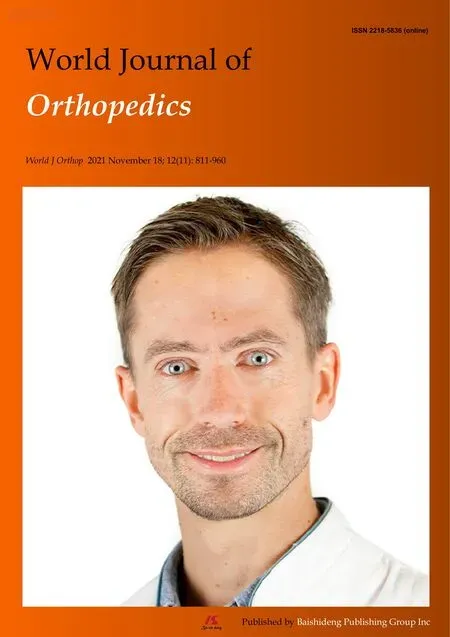 World Journal of Orthopedics2021年11期
World Journal of Orthopedics2021年11期
- World Journal of Orthopedics的其它文章
- Management of acute length-unstable Monteggia fractures in children: A case report
- Spontaneous pneumothorax in a 17-year-old male patient with multiple exostoses: A case report and review of the literature
- Pathological humerus fracture due to anti-interferon-gamma autoantibodies: A case report
- Allergic dermatitis after knee arthroscopy with repeated exposure to Dermabond Prineo? in pediatric patients: Two case reports
- Role of coatings and materials of external fixation pins on the rates of pin tract infection: A systematic review and meta-analysis
- Femoral lengthening in young patients: An evidence-based comparison between motorized lengthening nails and external fixation
